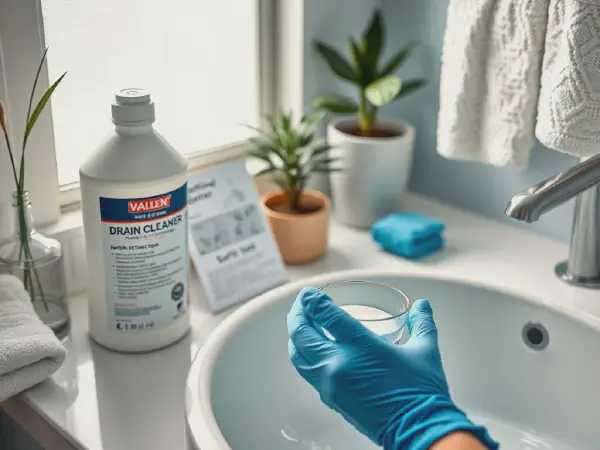How to Use Drain Cleaners Safely: Your Step-by-Step Guide

Understanding Drain Cleaners: A Comprehensive Guide
Drain cleaners are essential products for maintaining the health of your plumbing system. They are designed to break down and dissolve clogs, hair, grease, soap scum, food particles, and other debris that can build up over time. Using the right drain cleaner can save you from costly plumbing repairs and prolong the life of your pipes.
There are various types of drain cleaners available in the market, ranging from harsh chemical solutions to environmentally friendly options. Each type works differently, and understanding these differences can help you choose the most effective cleaner for your specific plumbing needs. Whether you're dealing with a minor blockage or a major obstruction, using the right drain cleaner can make a significant difference in the ease and effectiveness of the treatment.
It's crucial to follow the manufacturer's instructions when using any drain cleaner. Improper use can lead to damage to your plumbing, harmful fume exposure, or even accidents. Moreover, understanding when and how to use these products can help you avoid potential risks while effectively clearing your drains. Always consider the type of clog and the material of your pipes before deciding on a cleaner to avoid any unwanted mishaps.
In this article, we will cover the different types of drain cleaners, safety precautions to take, step-by-step application processes, environmental considerations, and when to seek professional help. With the right knowledge, you can tackle drain cleaning tasks confidently and safely while protecting your plumbing systems and the environment.
Drain cleaners play a crucial role in home maintenance, but they must be used wisely. Knowing the right cleaner for the job and taking precautions can save you time and money while keeping your drains flowing smoothly.
Types of Drain Cleaners
Chemical drain cleaners are the most common type found in households. They contain harsh chemicals that aim to dissolve clogs quickly. Sodium hydroxide and sulfuric acid are typical components, effectively breaking down grease, hair, and organic material. However, they can be hazardous to your health and plumbing if misused, so caution is paramount.
Enzymatic drain cleaners use natural enzymes and bacteria to break down organic matter slowly. They are a safer alternative to chemical cleaners and are ideal for regular maintenance. Although they may take longer to work, they are gentler on pipes and safer for the environment.
Natural drain cleaners often include ingredients like baking soda and vinegar or citrus-based solutions. These eco-friendly options can effectively clear minor clogs and prevent future build-up without the harsh chemicals found in conventional cleaners.
Caustic cleaners contain highly alkaline substances, while acidic cleaners utilize corrosive acids. Understanding the difference between these types is essential, as using an inappropriate cleaner can damage pipes. Caustic cleaners may work better for organic blockages, while acidic ones are better for mineral deposits.
Choosing the right cleaner depends on various factors, including the type of clog, the material of your pipes, and personal preferences for safety and environmental impact. Always read labels and select a product that is compatible with your plumbing system.
Safety Precautions
When using drain cleaners, it’s essential to wear protective gear such as gloves, goggles, and masks to avoid skin contact and inhalation of fumes. This will help minimize the risks associated with chemical exposure while working in confined spaces.
Ensure proper ventilation in the area where you are using drain cleaners. Open windows and doors, and use exhaust fans to disperse any harmful vapors that may be released during application. This practice can help maintain safe air quality while you work.
Avoid mixing different types of drain cleaners, as this can lead to dangerous chemical reactions. Always use one product at a time and follow the waiting times specified by the manufacturer to prevent accidents and ensure effective clog removal.
In case of spills, immediately follow first aid measures such as rinsing with plenty of water and seeking medical attention if necessary. It’s essential to familiarize yourself with the specific first aid instructions on the product label before use.
Store drain cleaners safely, out of reach of children and pets, and in a cool, dry location away from direct sunlight. Ensure that containers are tightly sealed to prevent leaks or spills that may pose safety hazards.
Step-by-Step Application
Before applying drain cleaners, prepare the area by removing any visible debris from the sink or drain opening. Also, ensure that the area is well-ventilated and free from any distractions to concentrate on the cleaning process effectively.
To apply the drain cleaner, carefully pour the recommended amount directly into the drain. Follow the instructions on the label for the most effective application method and avoid splashing. Allow the cleaner to sit for the specified time to work on the blockage.
Waiting times can vary based on the product and the severity of the clog. Typically, most cleaners require at least 15-30 minutes to take effect. For stubborn clogs, you may need to leave the cleaner overnight, but always check the product instructions for the recommended duration.
After waiting, flush the drain with hot water to help remove any residues and improve drainage flow. This step is crucial to ensure that the debris cleaned by the drain cleaner is washed away completely.
Signs that the blockage has cleared may include faster draining water and the absence of gurgling sounds. If problems persist after treatment, you may need to repeat the process or explore alternative solutions to address stubborn clogs.
Environmental Considerations
Eco-friendly alternatives to chemical cleaners include enzymatic and natural cleaners that use biodegradable ingredients. These options can effectively tackle clogs while having a minimal impact on the environment and your plumbing system.
Drain cleaners can affect plumbing and ecosystems when disposed of improperly. Harsh chemicals can corrode pipes and infiltrate water supplies, posing risks to public health and aquatic life. Choose products that are safer for both your plumbing and the environment.
Proper disposal of unused drain cleaners involves following local regulations regarding hazardous waste. Never pour chemicals down the drain or in regular trash; instead, take them to designated disposal facilities.
DIY natural drain cleaning methods such as using baking soda and vinegar can effectively clear minor blockages without resorting to chemical cleaners. Regular maintenance using these methods can help prevent the buildup of clogs in the first place.
Always check local regulations regarding drain cleaning chemicals to ensure compliance with safety standards. Proper awareness can help avoid fines and promote safer disposal practices.
When to Seek Professional Help
Signs that DIY doesn't work include persistent blockages, repeated backups, or slow drainage even after using drain cleaners. If you encounter such issues, it may indicate a deeper plumbing problem that requires professional intervention.
Choosing a plumber involves researching reputable local services, checking reviews, and verifying their qualifications. Getting estimates can also provide a clearer picture of the costs involved.
Cost considerations for hiring a plumber can vary widely based on the nature and location of the job. Assess your budget and get quotes from multiple professionals to ensure you receive fair pricing.
Preventive maintenance tips include regular cleaning of drains with natural alternatives, using drain screens to catch debris, and being mindful of what goes down the drains to minimize the chances of severe clogging.
Maintaining your drains involves periodic cleaning, avoiding harsh chemicals unless necessary, and staying vigilant for signs of plumbing issues. Addressing small problems early can save you from more expensive repairs down the line.
